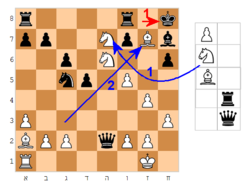- Crazyhouse
-
Crazyhouse is a chess variant similar to bughouse chess, but with only two players. It effectively incorporates a rule in shogi (Japanese chess), in which a player can introduce a captured piece back to the board as his own.
Contents
Rule differences from normal chess
- A captured piece reverses colour and goes to the capturing player's 'reserve', or 'pocket'. At any time, instead of making a move with a piece on a board, a player can 'drop' a piece, in his reserve, onto an empty square on the board.
- Promoted but captured pawns are dropped as pawns.[1]
- Pawns must not be dropped on the first or eighth ranks.[1]
- Drops which cause immediate checkmate are allowed. Unlike in shogi, this includes pawn drops.[1]
- A check that would cause checkmate, in regular chess, can be answered if the defender can make a legal drop which blocks the check.[2]
Notation
When recording games, an extension of the usual algebraic notation for chess is used, so that drops can be specified. Drops first give the piece type, followed by an @ symbol, then the target square. For example, "P@d5" means "pawn is dropped on d5 from reserve".[2]
Strategy
Crazyhouse, which has been analysed much less than regular chess, requires different strategies. Pawns and knights increase in relative importance in crazyhouse, while rooks, queens, and bishops decrease in relative importance. If a king is put in check by any of the latter three pieces, from two or more squares away, dropping a pawn next to the king becomes defensively useful. A knight, on the other hand, cannot be blocked by anything and its offensive value is more manifest. That piece can be used effectively to maintain a strategic influence over a region. After an early exchange of queens, it is usually unwise to reintroduce the queen too soon, particularly if she can be harassed by dropped minor pieces. Careful preparation is needed, in order to reintroduce the queen to maximum effect. Pawns could be dropped deep in the enemy position where, for example, they can fork pieces or give an uncomfortable check.
Variations
Minor variations of the rules are possible, such as:
- Loop Chess - promoted pawns keep their rank when captured.[3]
- Chessgi, Neo Chess - promoted pawns keep their rank when captured; pawns may be dropped on the first rank.[4]
References
External links
- Crazyhouse by Fergus Duniho
- Database of Crazyhouse games
Categories:- Chess variants
Wikimedia Foundation. 2010.

